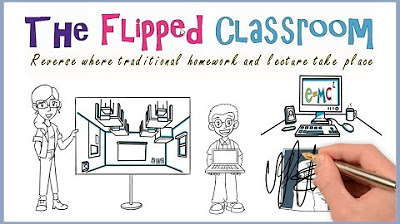What Is Flipped Learning?
Summary
TLDRThe transcript explores the concept of flipped classrooms, where students engage with learning materials outside of class, allowing for more interactive and personalized instruction during class time. The origin of the flip learning movement is traced back to 2006-2007, emphasizing the importance of teachers creating their own content to enhance student interaction and learning. The speaker challenges the traditional flipped model, advocating for project-based and inquiry-driven experiences. Strategies for ensuring video engagement and addressing access issues are discussed, ultimately positioning the flipped classroom as a gateway to deeper learning strategies.
Takeaways
- 🎓 The essence of a flipped classroom is to provide more time for active learning and engagement, with students working on projects and discussions during class time.
- 🔬 In a flipped classroom, science and food classes may involve hands-on experiments and cooking, respectively, with teachers circulating to assist students.
- 📚 The concept of flipping a classroom originated from the idea of delivering content outside of class time, allowing for more interactive activities in the classroom.
- 📈 Flipped learning began to gain traction in 2006-2007, with the realization that students could benefit from accessing lectures outside of the classroom setting.
- 🎥 The flipped classroom is not solely about videos; it's about the active, engaged learning that can happen in class as a result of pre-watched content.
- 🛠️ Teachers are encouraged to create their own content for flipped learning, as this can enhance the learning experience and ensure students are interacting with the material.
- 🤔 The best use of face-to-face class time is not for lectures but for activities where students apply, analyze, and create knowledge.
- 👀 Accountability is key in flipped learning; if students do not watch the videos, they should be made to do so during class time while others engage in productive activities.
- 📈 Flipped learning can lead to significant improvements in student performance, as seen in the increase in test scores by one standard deviation in the example provided.
- 🌐 Access to internet and video content is widely available, with 95% of students in the U.S. having access at home, and solutions for those without access.
- 🚀 Flipped classroom serves as a gateway to deeper learning strategies, encouraging teachers to implement more interactive and student-centered lessons.
Q & A
What is the primary characteristic of a flipped classroom?
-In a flipped classroom, students actively engage in learning activities such as experiments or discussions during class time, with the teacher providing more individualized help, rather than delivering lectures.
When did the concept of flipped learning begin for the speaker?
-The speaker's work in flipped learning started in 2006-2007 after a conversation with Aaron Sams and their assistant director of curriculum instruction.
What was the pivotal moment that led to the creation of the flipped classroom model?
-The pivotal moment was when the assistant director mentioned her daughter benefiting from recorded lectures, which led to the idea of delivering content outside of class and doing classwork at home.
What is the common misconception about flipped classrooms?
-A common misconception is that flipped classrooms are just about watching videos at home and doing worksheets in class, but the real magic happens with projects, design inquiry, and experiential learning.
What does the speaker suggest as the best use of face-to-face class time?
-The speaker suggests that the best use of face-to-face class time is not for the teacher to lecture but for students to apply, analyze, and create, transforming the classroom into an active learning environment.
How does the speaker address the issue of students not watching the videos?
-The speaker suggests holding students accountable for their actions, such as requiring them to watch the videos in class while others are getting help and working in groups.
Why does the speaker recommend teachers create their own content for flipped classrooms?
-The speaker recommends creating original content because it enhances the learning experience, allows for interaction, and ensures that the content is tailored to the students' needs.
What is the role of technology in ensuring students watch the videos?
-Technology can be used to track students' progress, such as how much of the video they watch and their responses to questions that pop up during the video.
What is the speaker's stance on using YouTube for flipped classroom videos?
-The speaker is a fan of YouTube if it is not blocked, as it is accessible on almost every device, making it a convenient platform for students to watch the videos.
What is the entry point for teachers who want to implement the flipped classroom model?
-The entry point is to flip a single lesson rather than an entire class, starting with a lesson that the teacher finds themselves repeating often.
What was the impact of flipping lessons on the speaker's students' performance?
-Flipping lessons led to students taking more ownership of their learning, with a significant increase in their test performance, by one standard deviation.
Outlines

Cette section est réservée aux utilisateurs payants. Améliorez votre compte pour accéder à cette section.
Améliorer maintenantMindmap

Cette section est réservée aux utilisateurs payants. Améliorez votre compte pour accéder à cette section.
Améliorer maintenantKeywords

Cette section est réservée aux utilisateurs payants. Améliorez votre compte pour accéder à cette section.
Améliorer maintenantHighlights

Cette section est réservée aux utilisateurs payants. Améliorez votre compte pour accéder à cette section.
Améliorer maintenantTranscripts

Cette section est réservée aux utilisateurs payants. Améliorez votre compte pour accéder à cette section.
Améliorer maintenantVoir Plus de Vidéos Connexes
5.0 / 5 (0 votes)






